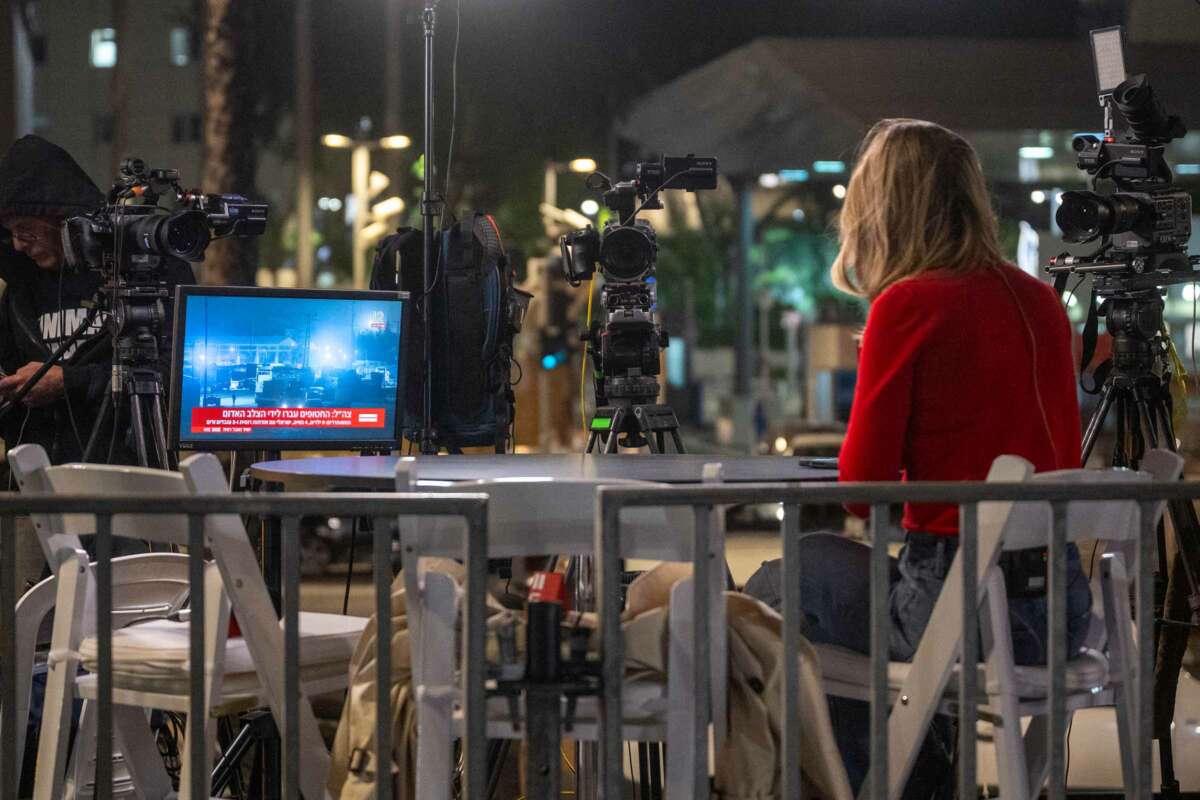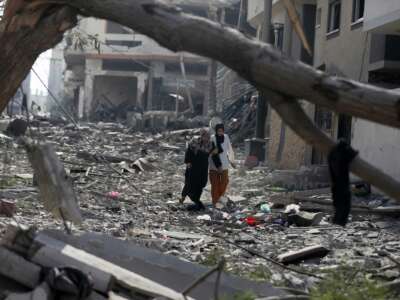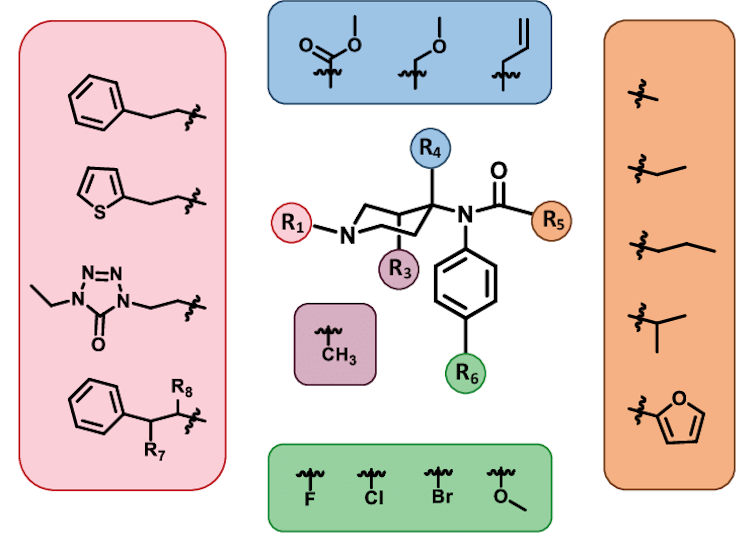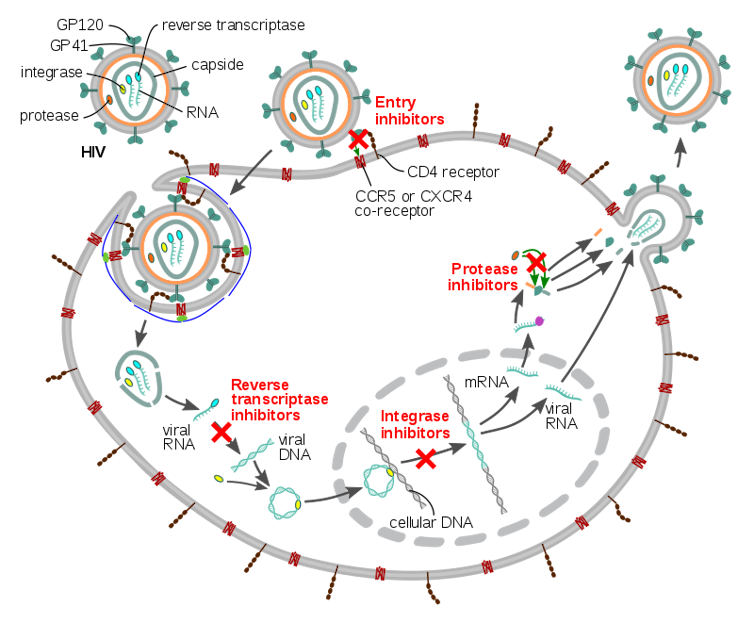Corporate media outlets have treated Palestinian suffering as a nonstory for many decades.
By Andy Lee Roth & Mickey Huff ,
December 2, 2023

A news anchor waits for a broadcast during the third day of the temporary ceasefire on November 25, 2023, in Tel Aviv, Israel.
ALEXI J. ROSENFELD / GETTY IMAGE
Gaza has continued to capture news headlines since the Hamas attacks on October 7 and the beginning of Israel’s increasingly disproportionate military response, which has brought the full might of the Israel Defense Forces (IDF) to bear on Palestinian civilians and children, prompting serious allegations of war crimes and genocide. “We are fighting human animals and we act accordingly,” Israel’s defense minister, Yoav Gallant, infamously stated.
But, for decades, U.S. corporate media have treated Gaza’s inhabitants as nonpersons, and daily life in Gaza as non-news. News media omissions often function as tacit permission for abuses of power. Corporate media didn’t create the violent, inhumane conditions in Gaza, but their shameful legacy of narrow, pro-Israel coverage indirectly laid the groundwork for the atrocious human suffering taking place there now.
The corporate media’s extended erasure of Gaza and its inhabitants is certainly rooted in the tacit (and sometimes overt) racism that distorts much news coverage of the Middle East in general and Palestine in particular. For example, Holly Jackson of the University of California, Berkeley, conducted a content analysis of reports published in The New York Times, The Washington Post, and The Wall Street Journal, from October 7 to October 22, 2023, and found disproportionate coverage of Israeli deaths compared to Palestinian ones and marked differences in the language used to describe those deaths.
But misleading coverage is also a result of corporate news outlets’ relentless, myopic focus on novel, dramatic events rather than long-term, systemic issues. As media critics Robert Hackett and Richard Gruneau noted in The Missing News (2000), for corporate media, “News is about what went wrong today, not what goes wrong every day.”
Gaza has continued to capture news headlines since the Hamas attacks on October 7 and the beginning of Israel’s increasingly disproportionate military response, which has brought the full might of the Israel Defense Forces (IDF) to bear on Palestinian civilians and children, prompting serious allegations of war crimes and genocide. “We are fighting human animals and we act accordingly,” Israel’s defense minister, Yoav Gallant, infamously stated.
But, for decades, U.S. corporate media have treated Gaza’s inhabitants as nonpersons, and daily life in Gaza as non-news. News media omissions often function as tacit permission for abuses of power. Corporate media didn’t create the violent, inhumane conditions in Gaza, but their shameful legacy of narrow, pro-Israel coverage indirectly laid the groundwork for the atrocious human suffering taking place there now.
The corporate media’s extended erasure of Gaza and its inhabitants is certainly rooted in the tacit (and sometimes overt) racism that distorts much news coverage of the Middle East in general and Palestine in particular. For example, Holly Jackson of the University of California, Berkeley, conducted a content analysis of reports published in The New York Times, The Washington Post, and The Wall Street Journal, from October 7 to October 22, 2023, and found disproportionate coverage of Israeli deaths compared to Palestinian ones and marked differences in the language used to describe those deaths.
But misleading coverage is also a result of corporate news outlets’ relentless, myopic focus on novel, dramatic events rather than long-term, systemic issues. As media critics Robert Hackett and Richard Gruneau noted in The Missing News (2000), for corporate media, “News is about what went wrong today, not what goes wrong every day.”
It is impossible to accurately grasp the current situation without discussing the concept of settler colonialism. By John Collins , TRUTHOUT October 11, 2023
For decades, Project Censored has highlighted slant, marginalization and outright censorship in mainstream U.S. news coverage of Israel and Palestine — in effect, the long-term buildup to what Alan MacLeod has described as a pro-Israel, anti-Palestine “propaganda blitz” by corporate media since October 7.
Corporate media have failed to cover Israel’s repression of Palestinian media and the efforts of Canary Mission and other Zionist organizations to stifle free speech and to blacklist advocates of Boycott, Divestment and Sanctions (BDS), while censoring efforts to expose the pervasive influence of pro-Israel lobbying. Historically, U.S. corporate media have failed to adequately cover continuing human rights abuses in Palestine, including the detention of Palestinian children; how private corporations profit from Israeli occupation; and the role of the World Bank in funding the West Bank apartheid wall — not to mention U.S. complicity in providing arms used for war crimes. The violence since October 7 has brought new attention to many of these issues, but when Project Censored originally highlighted these stories, each had been either marginalized or altogether silenced by the establishment press.
For decades, U.S. corporate media have treated Gaza’s inhabitants as nonpersons, and daily life in Gaza as non-news.
Notably, each of these stories — which were covered by independent journalists and news outlets — addressed ongoing, systemic issues rather than single, discrete events. The Israeli blockade of Gaza, for example, dates back to 2005-2006, and has been permanent since 2007, when Hamas took political control of the strip. But as exemplified by 2014 reporting about Israel restricting food imports to Gaza — effectively using hunger to coerce Palestinians in Gaza to reject Hamas — the daily realities of state violence and ethnic subjugation are not typically deemed newsworthy by U.S. corporate media outlets.
Like the violence that’s made headlines since October 7, the erasure of Palestinians by establishment news outlets in the United States is nothing new. To assess how U.S. news readers have been “encouraged to think about Palestinians,” historian Maha Nassar, the author of Brothers Apart: Palestinian Citizens of Israel and the Arab World, examined 50 years of editorials, staff columns and guest opinion pieces published by The New York Times, The Washington Post, The New Republic and The Nation. Nassar found that the most prominent U.S. news outlets “hosted thousands of opinion pieces on Israel-Palestine over 50 years,” but “hardly any were actually written by Palestinians.” For example, less than 2 percent of the 2,490 opinion pieces that The New York Times published from 1970 to 2019 were authored by Palestinians. As a result, Nassar observed, “readers’ views were shaped by columnists whose copious opinion pieces about Palestinians ranged from the annoyingly condescending to the outright racist.”
From the opinion section to headline news reports, Western news outlets have failed to adhere to basic journalistic standards in covering the violence in Gaza and the West Bank since October 7. News reports marred by egregious examples of mistranslation and failures to convey the context of events exemplify this failure. “Terms such as ‘unprovoked attack’ often ignore prior events,” the Arab and Middle Eastern Journalists Association cautions in its media guide for newsrooms that seek to provide accurate and critical coverage of Israel and Palestine.
“Take note of when reporters tell you the latest violence ‘started,’” Peter Hart of Fairness and Accuracy in Reporting advised back in 2012, “They’re picking a starting point for a reason.” Nevertheless, corporate news outlets continue to present timelines that position Israel as responding to Palestinian violence. This conventional frame reinforces biased distinctions between “worthy” and “unworthy” victims.
Corporate news outlets tend to ignore or provide only intermittent and superficial coverage of news about journalism itself. Coverage of violence in Gaza since October 7 has unfortunately followed this pattern. The corporate press have not adequately covered the killing of reporters in Gaza and the West Bank. Nevertheless, the Committee to Protect Journalists (CPJ) reports that Israel’s war on Gaza has taken a “severe toll” on journalists. As of November 30, preliminary investigations by CPJ documented at least 57 journalists and media workers among those killed since the current phase of conflict erupted on October 7. Another 11 journalists were reported injured, three reported missing, and 19 reported arrested. The CPJ report duly noted that the IDF informed Reuters and AFP that it “cannot guarantee” the safety of their journalists operating in Gaza.
Western news outlets have failed to adhere to basic journalistic standards in covering the violence in Gaza and the West Bank since October 7.
U.S.-based journalists have faced different threats. Alan MacLeod reported that CNN, The Hill and the Associated Press have all fired staff members for crossing red lines by advocating for a free Palestine or characterizing Israel as an apartheid state. As Truthout reported, MSNBC dropped Mehdi Hasan’s show after he stood out as one of the only news anchors on a major broadcast outlet to publicly oppose Israel’s brutality. Previously, Truthout reported, Israel had considered barring Al Jazeera journalists from covering Israel’s war on Palestinians. Condemnation by press freedom advocates appears to have forestalled this aim, but Israel has throttled the flow of information about events in Gaza in other, more sweeping ways.
On October 13, the nonprofit organization Access Now reported that Israel was imposing an internet blackout on the Gaza Strip, which the global digital rights organization called out as “an attack on human rights.” As a result of the “near-complete blackout” of all communications, “access to information has become scarce, directly impacting the capacity to document atrocities perpetrated on the ground,” Access Now reported.
On October 27, as Israel prepared for a ground invasion of Gaza, Access Now issued a joint statement with the Arab Alliance for Digital Rights calling for an “immediate reversal” of the ongoing “total communications blackout.” The statement noted that Israeli airstrikes had targeted telecommunication installations, “destroying two of the three main lines for mobile communication” and “leaving 11 internet service providers operating in Gaza now completely shut down due to infrastructural damage.” As Project Censored has previously reported, based on past work by Global Access and other digital rights organizations, internet shutdowns often provide cover for atrocities.
Although establishment press outlets, including The Washington Post and The New York Times, have covered Israel’s communications blackout of Gaza, there have been two basic problems with this reporting. First, there was a lag of nearly two weeks between the first alarms sounded by digital rights groups and the newspapers’ coverage. Second, and perhaps more damning, is that even that tardy coverage has used language that diminishes the blackout’s consequences. The Washington Post’s October 30 report, for example, ran with a headline saying that internet disruptions “caused problems in Gaza over the weekend.” As if the issue were interrupted Netflix streams, rather than access to emergency services and trustworthy information.
While Biden administration officials claim the U.S. is “unable to exert significant influence” on Israel, even as the U.S. simultaneously maneuvers to undertake a next round of arms deals with Israel “in complete secrecy” without congressional oversight, the American public continues to be left in the dark — not only about the extent and balance of violence in Gaza, but also the United States’ role in “supporting a military that experts say has been committing war crimes in Gaza and beyond.”
As Israel’s assault on Gaza escalates without respect for international law, this is grim, deadly business. Though it may seem inconsequential, bolstering support for truly independent news outlets that provide diverse, critical and trustworthy reporting in the public interest has never been more important or, potentially, consequential. Compared with corporate news outlets, independent news outlets — including Truthout, where you’re reading this article — not only employ more inclusive definitions of who and what count as “newsworthy,” they also act as powerful checks on the official narratives and atrocity propaganda peddled, with disturbing regularity, by their corporate counterparts.
ANDY LEE ROTH is associate director of Project Censored, a news watch organization that promotes independent journalism and critical media literacy education. With Mickey Huff, he co-edited Project Censored’s newest yearbook, State of the Free Press 2024, to be published by The Censored Press and Seven Stories Press on December 5, 2023.
MICKEY HUFF is the director of Project Censored, a news watch organization that promotes independent journalism and critical media literacy education. With Andy Lee Roth, he co-edited Project Censored’s newest yearbook, State of the Free Press 2024, to be published by The Censored Press and Seven Stories Press on December 5, 2023.
Media’s Selective Moral Outrage Manufactures Consent for Palestinian Genocide
Western support for Israel is not merely about Israel itself but is also about setting a new international norm.
Media’s Selective Moral Outrage Manufactures Consent for Palestinian Genocide
Western support for Israel is not merely about Israel itself but is also about setting a new international norm.
By Jamil Khader ,
October 18, 2023

Supporters of Palestine demonstrate outside of BBC Alba to condemn the recent fighting in Gaza on October 14, 2023, in Glasgow, Scotland.
JEFF J MITCHELL / GETTY IMAGES
In a viral post on X, former Greek Finance Minister Yanis Varoufakis ignited an intense debate about selective condemnation and moral outrage surrounding Israel’s massive bombardment of Gaza, which the Palestinian envoy to the United Nations described as “nothing less than genocidal.” Varoufakis stated:
In a viral post on X, former Greek Finance Minister Yanis Varoufakis ignited an intense debate about selective condemnation and moral outrage surrounding Israel’s massive bombardment of Gaza, which the Palestinian envoy to the United Nations described as “nothing less than genocidal.” Varoufakis stated:
I condemn every killing with equal passion. What I refuse to do is to join the ritualistic condemnation of one side whose very purpose is to take the side of a state cynically, intertemporally and brutally imposing Apartheid over many decades. This is no different to 1981 when as Anti-Apartheid demonstrators in London we were being pushed by the British media to condemn the [African National Congress] for necklacing (a horrible practice indeed) – a condemnation sought by those who sought to undermine the Anti-Apartheid struggle at a time, lest we forget, Nelson Mandela was branded by the US, UK & Israeli gvts a terrorist.
In the case of the anti-apartheid struggle in the 1980s, necklacing was an extrajudicial killing that became notorious in South Africa. Varoufakis highlights the complexities and ethical dilemmas that often arise in resistance movements, particularly when they are up against oppressive regimes.
His statement was condemned by liberals and some leftists as antisemitic because he allegedly refused to “condemn the killing of babies just because they are Jews.” Varoufakis, however, points out that the call to condemn Hamas in a one-sided statement was not simply a call to denounce violence. It was a strategic move designed to delegitimize the broader struggle for freedom in Palestine.
Varoufakis’s post criticizes the selective moral outrage that often characterizes public discourse on what some refer to as complex geopolitical issues. However, as Israel’s military offensive has morphed into a genocidal war and Israel’s “moral high ground” dwindles, selective expressions of moral condemnation have taken on a political meaning that manufactures public consent and provides cover for Israel’s violations of international law.
In my career as a Gazan American physician, I’ve delivered 1,000 babies. Israel has killed that many children in a week.By Dana Elborno , TRUTHOUTOctober 17, 2023
Selective moral posturing is primarily mobilized as a smokescreen for Israel’s territorial expansion as well as Western neo-imperial agendas, in which the settler-colonial Jewish apartheid ethnocratic state occupies a central position.
The Perverted Ethics of Moral Posturing
In an article in London Review of Books published in the aftermath of the Israeli bombardment of Gaza, the Jewish American philosopher Judith Butler argues that selective moral outrage obscures the pain and suffering of other victims as well as the structural injustices that give rise to violence in the first place. They (Butler) maintain that contextualizing violence is not the same as relativizing or downplaying violence.
Butler addresses the ethics of selective condemnation within the limits of Western media’s framing of the Palestinian struggle for freedom. They criticize the way certain selective discourses are used to dehumanize Palestinians, arguing that this language perpetuates colonial racism and makes it easier to justify violence against those who are portrayed as “less than human.”
Butler’s point is that selective condemnation is not a genuine expression of ethical principles, because it does not ask for a nuanced understanding of what exactly is being condemned. They maintain that educating ourselves about “the history of colonial violence” in Palestine should not threaten our moral position.
The manipulation of photos of Palestinian victims by Hollywood celebrities and the use of AI-powered apps to express solidarity with the very forces responsible for Palestinian victimization are glaring examples of the absurdity and perversity of these selective expressions of moral indignation. The fact that Jamie Lee Curtis and Justin Bieber were under the “mistaken belief” that the images they posted were from Israel just shows the extent to which these condemnations rely on ignorance.
The layers of irony here are hard to miss. It’s not only that, as Butler suggests, morally indignant people ought to understand the “political formations” that they oppose; they should critically examine the formations they support. Moreover, their gimmick inadvertently shows the truth of “false equivalence” in the Palestinian struggle for freedom that Israeli hasbara tries to distort through messages about symmetry between Israel, the most powerful military power in the Middle East, and the Palestinian people.
Finally, Israeli lies about Hamas “decapitating babies” must be read not only in the context of antisemitic blood libel accusations used against European Jewry; they should also be read in relation to the lies about Iraqi soldiers, who were falsely accused of snatching “babies out of incubators” in Kuwaiti hospitals. These lies helped build public support for the United States’ invasion of Kuwait in 1991 and the destruction of Iraq in the Gulf War.
Politicizing Condemnation: The New Nakba
Butler’s ethical position should be supplemented by Varoufakis’s insistence on politicizing these ritualistic condemnations. For one, Butler seems to demand a clear moral position without ambiguity. But there is a clear difference between Varoufakis and Butler on the tension between political diversity and violence. While Varoufakis seems to accept violent forms of resistance within emancipatory movements, Butler recognizes the diversity of Palestinian groups while envisioning a future where groups like Hamas could be “dissolved or superseded by groups with non-violent aspirations for cohabitation.”
More importantly, Varoufakis seems to suggest that ritualistic condemnations are not primarily about upholding ethical or legal standards, but rather serve to further Israel’s geopolitical aims and Western neo-imperial hegemony. In the context of Israel’s genocidal war on Gaza, such righteous condemnation is meant to not only overshadow the broader struggle against systemic injustice and oppression; it also functions as a smokescreen for Israel’s territorial expansion.
It has become clear that Israel’s genocidal war on Gaza is a part of the Zionist settler-colonial project and Israeli territorial expansion grounded in a protracted ethnic cleansing and displacement. This is not, as some believe, a war between extremists on both sides, or an attempt to resolve the internal contradictions in the settler-colonial apartheid state that resulted from the rise of a messianic Zionist settler movement.
Zionism is project hell-bent on wiping “human animals” from the earth and occupying their land. Israel’s emergency government includes extremists who have been calling for another Nakba. As Knesset member Ariel Kallner made clear, there is “one goal: Nakba! A Nakba that will overshadow the Nakba of [19]48.” Meanwhile, Israeli President Isaac Herzog blamed all Gazans for the Hamas attack, bringing to the forefront Israel’s disdain for the value of indigenous civilian life in Palestine.
Israel’s genocidal war on Gaza is clearly expansionary. In settler-colonial logic, “self-defense” is code word for territorial expansion. In a recent interview, Israeli Minister Gideon Sa’ar said Gaza “must be smaller at the end of the war” and that “whoever starts a war against Israel must lose territory.” He explained that “they do have to pay the price of loss,” in order to “impose a security cordon” and tighten the siege on the Gaza Strip.
Moreover, these colonial expansion plans have been accompanied by evacuation orders that aim at emptying Gaza of its Indigenous inhabitants. Last week, Israel ordered 1.1 million Palestinians in Gaza to flee south. This evacuation must be understood in the context of Israeli policies of population transfer, displacement and ethnic cleansing that aim to eradicate the Indigenous population and replace it with settlers.
The political analyst Talal Awkal drew parallels between the mass exodus of Palestinians in 1948 and 2023, calling both events a Nakba, “You look at those pictures of people without cars, on donkeys, hungry and barefoot, getting out any way they can to go to the south.” He added, “They are displacing an entire population from its homeland.”
There are already voices in Israel calling for razing Gaza and creating a natural reserve in its place. This is a form of settler-colonial greenwashing at its best. Only a settler colonizer can advocate for environmental preservation while calling for the erasure of an Indigenous people. Clearly, in this fascist ideology, neither the Indigenous “human animals” nor their animals are deemed fit for such natural reserves.
Western Hegemony and Rewriting International Law
In this context, ritualistic condemnation becomes a tool not only to advance Israel’s Zionist settler-colonial project but also Western interests, in which Israel’s military and surveillance technology are instrumental. It reveals the geopolitical interests that often underlie moral posturing on the international stage.
It’s enough to contrast the reactions of European Union Commission President Ursula von der Leyen to Israel’s attack on Gaza and to the Russian invasion of Ukraine to see how these geopolitical interests shape selective moral condemnations. Amid Russia’s invasion of Ukraine last year, von der Leyen labeled Russian attacks on civilian infrastructure that aim to “[cut] off men, women and children of water, electricity and heating” despite the cold winter “war crimes” and “acts of pure terror.” The same actions by Israel were endorsed and supported.
Further, the viciousness of Israel’s genocidal war in Gaza is meant to compensate for its humiliation by rehabilitating its mythic military aura as an impregnable fortress in the eyes of neocolonial powers and the subsidiary regimes that have become dependent on it. David Lloyd, a founding member of the U.S. Campaign for the Academic and Cultural Boycott of Israel, put it correctly when he wrote:
[Israel’s] desperate descent into extremism and settler rage belongs with the supremacist logic that founded the Zionist state: a settler colonial enterprise, grounded in the assumption of racial superiority and unsustainable without a perpetual demographic war against its indigenous population, necessarily resorts to ever more brutal and unconcealed outrages in order to sustain its supremacy.
Israel, as journalist and author Antony Loewenstein shows, has been exporting its advanced militarized counterinsurgency methods, surveillance technologies and ethnocratic ideology to countries around the world, which use them in turn to repress dissidents, refugees and oppressed communities. These technologies are usually first tested in the occupied Palestinian territories before they are exported to the world in exchange for money and political support in international organizations.
More importantly, Israel’s military actions, supported by Western powers, serve as a signal to other global actors who dare defy the international hegemonic order. This includes both regional players in the Arab world and international actors like Iran and North Korea.
For this reason, Israeli commentators and Western observers and officials have framed Israel’s genocidal war within Samuel Huntington’s defunct “clash of civilizations” paradigm. Underlying this rhetoric is a fearmongering campaign based on Islamophobia and the racialized representation of Palestinians and Muslims in general as “human animals.”
The Israeli TV Channel13 has been using an “Israel Now, the West is Next” disinformation campaign, with deep fake imagined attacks on major European cities. Moreover, an opinion piece in Ynetnews equates Israel’s war with “the war of the Free World.” The op-ed claims that Israel is at the forefront of the battle between the free world and the Jihadist movement, and calls for unity in defeating the “axis of evil” led by Iran. Republican Sen. Lindsey Graham toed this same line by claiming that, “They [Iran and Hamas] want to destroy the Jewish state. We’re in a religious war and I unapologetically Stand with Israel.”
Republican presidential candidates also wasted no time in weaponizing this Islamophobic language. Republican presidential hopefuls Florida Gov. Ron DeSantis and Vivek Ramaswamy want to crack down on Muslims in ruthless campaigns, with comments amounting to if it could happen to Israel, it could happen here. This kind of rhetoric has already claimed the life of a 6-year-old Palestinian boy in Illinois.
One-sided Western support for Israel is not merely about Israel itself but, as journalist and author Jonathan Cook writes, is also about setting a new international norm. By backing Israel’s actions, Western politicians are implicitly endorsing a new set of rules that could benefit their states in the future. While the killing of civilians on both sides is a violation of international law, Israeli leaders’ declarations reveal genocidal intent as defined by Article 6 of the Rome Statute. International law does not permit Israel to commit war crimes against civilians in retaliation for Hamas’s actions.
Rewriting international law serves a dual purpose: First, it provides Israel with the latitude to conduct military operations as it sees fit. Second, it offers Western nations a cover to sidestep international legal restrictions that they themselves might wish to avoid in the future.
Any progress in the Palestinian struggle for freedom requires confronting the role of the Western powers, especially the U.S., in enabling Israeli hegemony and the destruction of the Palestinian people. In a telling move, according to HuffPost, the U.S. State Department sent a memo discouraging diplomats from using from using three specific phrases: “de-escalation/ceasefire,” “end the violence/ bloodshed” and “restoring calm.”
The Western plans for a new Middle East are clearly based on the disappearance of the Palestinians or their absorption in neighboring countries. However, as Cook and Loewenstein aptly put it, the battlefield extends beyond the geographical confines of Israel and Gaza. Underlying the geopolitical scene is the pervasive excrementalization of racialized bodies under the necro-capitalist regime. It is a larger struggle against divisive necro-capitalist ideologies that categorize humanity and “human animals,” the mournable and ungrievable, the privileged and the “worst-off.” If we allow these ideologies to prevail, as Cook writes, “they’ll make Palestinians of us all.
JAMIL KHADER Ph.D., is dean of research and professor of English at Bethlehem University.





















